St Birinus
St. Birinus pilgrimage walks
Who was Birinus – or Berin?
Driving along the A4074 between Wallingford and Oxford you pass through the village of Berinsfield. You might wonder who was this Berin who owned a field here. He was better known by his Latin name Birinus, but back in the 7th century Berin was his Saxon name. He gave his name to a hill near Dorchester too, so who was he?
Although in the time of the Roman Empire Christianity had reached England, once the empire fell and Romans retreated the Saxons reverted to old ways. Eventually Kent and Nothumbria returned to the Gospel, but much of ‘inner England’ was pagan. So Pope Honorius 1 sought out a Benedictine monk called Birinus to send as missionary to this land. After being made a Bishop, he arrived in England in 635 and headed inland to found his diocese.
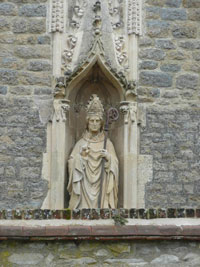 Statue of St.Birinus on a church dedicated to him.
Statue of St.Birinus on a church dedicated to him.
Meanwhile the king of the West Saxons, Cynegils, seeking the hand of the daughter of the Christian King Oswald of Northumbria, was keen to learn more about the Gospel. So he invited Birinus, as an emissary of the Pope, to meet him at a sacred place high on the ancient Ridgeway – Churn Knob.
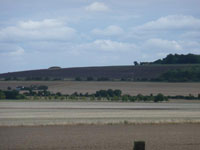 Churn Knob sticks up from Churn Hill.
Churn Knob sticks up from Churn Hill.
Here Birinus explained to him the good news of the Christian gospel, and Cynegils became a believer. Nearby the rivers Thame and Thames meet at Dorchester, and Birinus baptised Cynegils there in the Thame, with Oswald as his sponsor.
The two kings gave Birinus the former Roman garrison, now Dorchester, and here he founded his Cathedral, where Dorchester Abbey now stands.
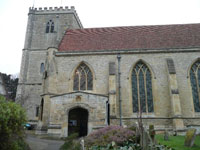
Abbey church Dorchester on Thames.
He went out from here preaching the Gospel in the surrounding country. His diocese soon extended from the coast to Towcester. In later times (under Bishop Wulffwig) it even extended to the Humber, before being split between Winchester and Lincoln.
Birinus died in 650 and was buried in Dorchester. However by 680 his relics were removed to Winchester (a church also founded by him) because of fears of war with nearby Mercia.
So when did the annual Pilgrimage begin?
Pilgrims probably visited the resting place of the saint soon after his death, to pray and seek his support in their prayers.
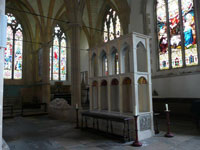 St.Birinus’ shrine in Abbey church Dorchester.
St.Birinus’ shrine in Abbey church Dorchester.
When the Cathedral was moved to Winchester, pilgrimages to Dorchester were no longer so significant, but were not forgotten.
Augustinian Canons later founded an Abbey at the former Cathedral. The Saxon cathedral was replaced by a new Abbey church, with the current building beginning in the 12th century. It was these monks who asked the Pope for permission (which was granted) to have a pilgrimage to Dorchester in honour of Birinus in mid-summer, instead of on his saint’s day which was in winter on 5th December. This tradition lasted until the dissolution of the Abbey by Henry VIII in 1536. The Abbey church, built over time with pilgrims’ bounteous gifts, was saved from destruction by a wealthy local man purchasing it from the king. It then became the Parish Church.
The pilgrimage was revived in 1977 in honour of the saint who brought the Gospel to the Thames Valley.
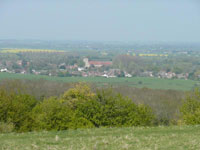 Dorchester and its Abbey from Wittenham Clumps.
Dorchester and its Abbey from Wittenham Clumps.
The traditional route from Churn Knob to Dorchester was identified, and has been used since to walk through lovely countryside remembering the saint. It starts on downland, descends to pretty villages with thatched cottages, crosses arable land, some low-lieing with drainage ditches, and climbs up over the Sinodun Hills.
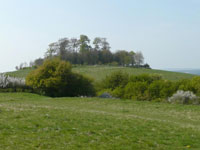 Round Hill from Castle Hill, Sinodun Hills.
Round Hill from Castle Hill, Sinodun Hills.
On the way pilgrims pass ancient monuments, hill-forts, pretty villages, and a tree inscribed with a poem. Since 2005 Pilgrims have carried a passport which is stamped with the seal of each church on the route as it is visited.
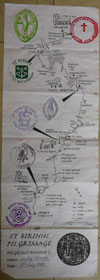 Birinus Passport.
Birinus Passport.
What does the pilgrimage involve?
Coaches are available (organisers need to know if you intend to use them) from Dorchester to fairly close to Churn Knob above Blewbury. Pilgrims gather at Churn Knob for a picnic, usually accompanied by Blewbury Brass Band.
Then, after a prayer, they set off on the walk, with St. Birinus’ banner carried at the front.
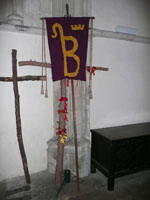 The Banner of St.Birinus.
The Banner of St.Birinus.
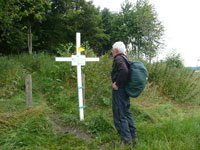 Reading a text on Round Hill.
Reading a text on Round Hill.
At certain points on the walk are posted meditations, and at each of 5 churches en route pilgrims enter to have their passport stamped.
 Stamping the passport at South Moreton.
Stamping the passport at South Moreton.
In Brightwell there are usually teas to refresh, and some less energetic pilgrims start from here. On reaching Dorchester, after getting their passports stamped at St.Birinus Catholic church, pilgrims relax over tea in the adjoining garden.
This gives time for slower ones to catch up, so all can go together in a formal parade to the Abbey for an ecumenical service of thanksgiving.
The Salvation Army band usually plays for the service, and pilgrims are given a certificate at the St.Birinus’ shrine.
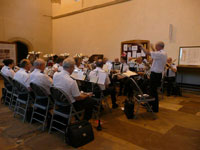 Salvation Army Band in the Abbey.
Salvation Army Band in the Abbey.
Following the service pilgrims usually enjoy a BBQ in the grounds adjoining the Abbey, before going their various ways home.
Others unable to walk are welcomed at the service and the BBQ.
How does this relate to Walkingworld?
The route of the pilgrimage has been written up as a Walkingworld Walk, no. 5340.
Also on Walkingworld you’ll find a series of walks called “In the Steps of St.Birinus”. These have been designed to enable you to complete the whole pilgrimage route in sections. Each walk is circular, overcoming the difficulty of transport posed by the end to end walk. Some sections are covered by 2 walks so you can choose a long or a short version. The walks in the series are:-
Walk 5341 St.Birinus part 1. Blewbury – Churn Hill – Blewbury 5.71 miles
Walk 5342 St.Birinus part 2 (long). Blewbury-S.Moreton-E.Hagbourne 9.19 miles
Walk 5375 St.Birinus part 2(short). Blewbury circuit north 6.83 miles
Walk 5528 St.Birinus part 3 (long). Wallingford – Brightwell 8.5 miles
Walk 5439 St.Birinus part 3(short). S.Moreton – Mackney – N.Moreton 6.4 miles
Walk 5440 St.Birinus part 4. Brightwell–Mackney–Sinodun Hills 6 miles
Walk 5443 St.Birinus part 5. Wittenham Clumps – Dorchester 5 miles